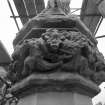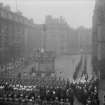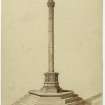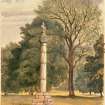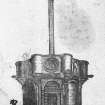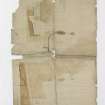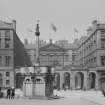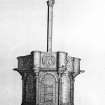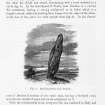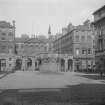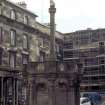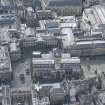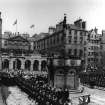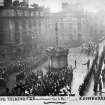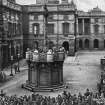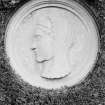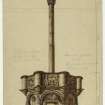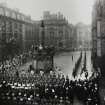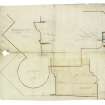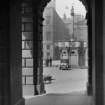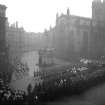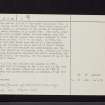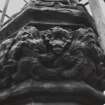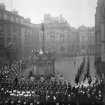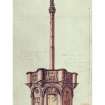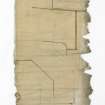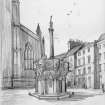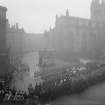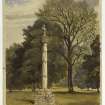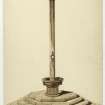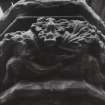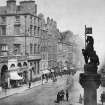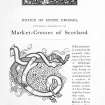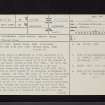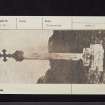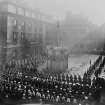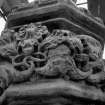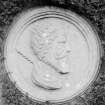Edinburgh, High Street, Market Cross
Market Cross (19th Century)
Site Name Edinburgh, High Street, Market Cross
Classification Market Cross (19th Century)
Alternative Name(s) Mercat Cross
Canmore ID 52546
Site Number NT27SE 8
NGR NT 25771 73597
Datum OSGB36 - NGR
Permalink http://canmore.org.uk/site/52546
- Council Edinburgh, City Of
- Parish Edinburgh (Edinburgh, City Of)
- Former Region Lothian
- Former District City Of Edinburgh
- Former County Midlothian
NT27SE 8 25771 73597.
(NT 2577 7359) Market Cross (NR) (restored)
(NT 2579 7361 and NT 2577 7360) Market Cross (NR) (sites of)
OS 1:1250 plan, (1970)
The Mercat Cross of Edinburgh is first mentioned in a charter of 1365 which indicates that it stood on the S side of the High Street, about 45ft E of the present E end of St Giles' Church (at NT 2577 7360). In 1617, the cross was taken down and re-erected on a new substructure lower down the High Street (at NT 2579 7361). This site is still marked by an octagonal arrangement of cobble stones. In 1756, the cross of 1617 was demolished; some parts were preserved, notably the capital and parts of the shaft, and re-erected at Drum House, Gilmerton (see NT36NW 35). Five of the eight circular medallions that had adorned the understructure are now built into the garden wall at Abbotsford (NT53SW 41), where there is also the basin of a fountain from which it is said that the central pillar of the Cross origianlly rose. A small oblong finial of freestone, which once formed part of the Cross, is preserved in the garden of Viewforth, Cammo Road, Barnton; it is dated 1641. The shaft, prior to 1756, was a single stone, but was broken, and five pieces were dressed square and clamped together to form the shaft at Drum, 13ft 11ins high. In 1866, the pieces from Drum House were set up on a new pedestal within the railings on the N side of St Giles' Church. In 1885, a new substructure was commissioned, and the cross was rebuilt on its present site. Finally, in 1970, Edinburgh Corporation replaced the shaft, preserving the unicorn finial, the capital, and two pieces of one of the old shaft stones.
The RCAHMS, who examined the capital in 1971, concluded that it belongs to the first half of the 15th century. The unicorn finial was set up in 1869 to represent the unicorn mentioned in accounts of the 1617 cross.
J C Robbie 1908; RCAHMS 1951; S Harris 1972.
As described.
Visited by OS (S F S) 26 November 1975.
See also EDINBURGH, High Street, City Chambers for photographs.
ARCHITECTS: David Bryce (Submitted design for restoration of Mercat Cross, Edinburgh)-not carried out
David Cousin (Submitted design for restoration of Mercat Cross, Edinburgh)-not carried out
Sydney Mitchell & Wilson-restoration
REFERENCE: EDINBURGH PUBLIC LIBRARY
"Drum of the Somervilles" 1928 by Hamilton Moir Nisbet, for the position of the Cross at Drum
REFERENCE: NATIONAL LIBRARY
Robert Louis Stevenson's "Edinburgh"-a sketch entitled "A Royal Proclamation"
"History of the Mercat Cross of Edinburgh" by Thomas Arnold, 1885- "Prospect of ye Mercat Crosse of Edinburgh 1750" and a reduced copy of the Architect's drawing of "The Market Cross as restored in 1885".
Publication Account (1951)
61. The Mercat Cross, High Street.
Besides fulfilling its primary function as the focal point for trade, the Cross also served at one time and, another such various purposes as a place of execution,* a centre of public rejoicings and entertainment, and the seat from which Royal proclamations were made. It must therefore always have ranked as one of the major monuments of the city although its early history, form, and situation remain unknown. It appears on record for the first time in a sasine, dated 1365 (1), which indicates that it stood at that period on the S. side of the High Street about 45 ft. E. of the present E. end of St. Giles' Church (2). In 1555 the Town Council, for some unspecified reason, but presumably because it had become unsafe, proposed to take it down and re-erect it upon the same site. Yet nothing seems to have been done immediately, and for several years afterwards small sums were disbursed for making minor repairs to it and cleaning. Its position was, however, inconvenient, as causing an obstruction to traffic; and in.1617, in order to widen the street preparatory to the visit of James VI, it was taken down and re-erected farther E., seamen from Leith lowering the old pillar safely.** The structure as rebuilt must have been of considerable size to judge by the number of masons employed; on one occasion, for instance, sixteen of them received extra pay for working a sixteen-hour day, from 4 a.m. "neir until aucht at night." Gordon's map of 1647 shows the new Cross in position. In 1756 it was demolished, the long pillar or cross-shaft being broken in the process; and to replace it a stone, which was declared by Act of Sederunt to be the Market Cross of Edinburgh, was affixed to the side of a neighbouring well. In the meantime, the larger part of the broken pillar had been re-erected with its capital at Drum House, Midlothian, while five of the eight circular medallions that had adorned the under structure were built into the front wall of Deanhaugh House, Stockbridge. On the demolition of this house in 1814, the five medallions were secured by Sir Walter Scott who built them into the garden wall of Abbotsford; and there they still remain in company with the basin of a fountain from which it is said that the central pillar of the Cross originally rose. A small oblong finial of freestone, which once formed part of the Cross, is likewise preserved in the garden of Viewforth, Cammo Road, Barnton.*** It is carved on back and front with the triple-towered castle of Edinburgh set on its rock, with a label dated 1641 above.
Within a century of its destruction tentative proposals were made to restore the Cross, and the movement gathered impetus a few years later when the owner of Drum House proposed to return the shaft and capital and the Town Council accepted the offer. Then arose a vigorous controversy regarding sites and styles, in which a joint committee of the Royal Scottish Academy and the Society of Antiquaries of Scotland played a prominent part; and, although the project for a complete restoration fell through, by 1866 the pillar, now returned, had been erected within a railing on the E. side of the N. door of St. Giles' Church. In 1885 Mr. Gladstone, then M.P. for Midlothian, supplied funds for a complete restoration of the landmark on the lines of Gordon's drawing, placing it in its present situation in the centre of the roadway at the E. end of the Church that is to say about 24 ft. S. of the position that it occupied in the 14th century. As it now stands, the Cross has an octagonal under structure carrying the platform from which Royal proclamations are read. Within this rises the surviving portion of the old shaft, about 14 ft. high and surmounted by a modern capital bearing a unicorn. On the E. side of the shaft has been carved the inscription THE OLD + OF EDR.
RCAHMS 1951
(1) Reg. Mag. Sig., i, p. 40. (2) P.S.A.S., xx (1885-6), p.384.
*The cross itself was not, of course, used as a scaffold.
**They were afterwards entertained to a “Disjoyne and Denner”, costing 24 pounds 15 shillings Scots, to the accompaniment of trumpets and a drum.
***In the same place may be seen some other carved stones brought together from various sources. These include fragments of capitals from two 17th -century gate-piers, differing in pattern; a 17th-century pediment enclosing a circular scrolled panel in which are displayed two baxter's peels and a besom ; three moulded rybats of the 16th century; a human mask of the 17th century, very rudely carved ; three stone balls , each 16 inches in diameter.
Project (1997)
The Public Monuments and Sculpture Association (http://www.pmsa.org.uk/) set up a National Recording Project in 1997 with the aim of making a survey of public monuments and sculpture in Britain ranging from medieval monuments to the most contemporary works. Information from the Edinburgh project was added to the RCAHMS database in October 2010 and again in 2012.
The PMSA (Public Monuments and Sculpture Association) Edinburgh Sculpture Project has been supported by Eastern Photocolour, Edinburgh College of Art, the Edinburgh World Heritage Trust, Historic Scotland, the Hope Scott Trust, The Old Edinburgh Club, the Pilgrim Trust, the RCAHMS, and the Scottish Archive Network.
Field Visit (1 October 2002)
White and gilt unicorn with a red and white shield carrying a saltire pennant sits on top of a capital carved with dragons and foliage (the only original part), which surmounts a tall octagonal shaft; the whole supported by an octagonal drum with eight coloured heraldic medallions (one on each side with the city arms facing the High Street). The structure can be entered and provides a platform for proclamations.
The first Mercat Cross stood in the middle of the High Street until 1617, when it was taken down 'to give greater effect to the royal procession of James VI on hid first visit to Scotland after his accession to the English crown.' (1) After the visit, the foundation of a new cross was laid a few yards to the south of the former site and the shaft of the old cross was placed on a new octagon building about 16 feet across. In 1756 this cross was ordered to be removed, because it was considered an encumbrance to the street. In 'Marmion', Sir Walter Scott laments this removal: "Dun-Edin's Cross, a pillar'd stone, / Rose on a turret octagon; / But now is razed that monument, / Whence royal edict rang, / And voice of Scotland's law was sent / In glorious trumpet clang. / Oh ! be his tomb as lead to lead / Upon its dull destroyer's head ! - / A minstrel's malison is said."
In about 1860 William Chambers, Lord Provost of Edinburgh, proposed to restore the cross. In 1861 The Builder reported that 'workmen have commenced to erect on the High-street, a little to the east of St. Giles's, and opposite to the opening in Parliament-square, a rough wooden outline or model of the cross which was taken down in 1756, and which it is now proposed to restore.' (2) However in November 1861 The Builder reported that the proposal to restore the cross had been abandoned, because the town-council had refused to grant the site. (3)
William Chambers' wish to restore the cross was eventually fulfilled, and The Builder could announce in February 1866 that 'the work of restoring the old city cross, in the space within the railing on the north side of St. Giles's Cathedral, is now in progress.' (4)
In March 1885 William Ewart Gladstone M.P. wrote to the Town Council of Edinburgh expressing his desire to undertake the restoration.
On 23 November 1885 the Town Council of Edinburgh took over the custody of the Mercat Cross, by accepting the key from William Gladstone.
Inspected By : D. King
Inscriptions : In tympanum above wooden studded door (incised Gothic letters):
DEO . GRATIAS / VETVSTVM . MONVMENTVM . CRVCEM . BVRCI / EDINENSIS . PVBLICIS . MVNERIBVS . AB . ANTIQVO . DICAM / CARMINE . TAM . EXIMIO . QVAM. VIRILI . A . SVMMO . HOMINE . GVATRO / SCOTT . ET . VINDICATAM . ET . DEFLETAM . PRAESVLIBVS / MVNICIPII . PERMISSV . REDINTEGRANDAM . CVRAVIT . GVL . E . GLADSTONE / STIRPE . ORIVNDVS . PER . VTRAMOVE . LINEAM . PENITVS . SCOTICA / A . S . MDCCCLXXXV . DIE . NOVEMBRIS . XXIV
Signatures : None Visible
Design period : Early 15th century to 1970
Year of unveiling : 1885 (present site)
Information from Public Monuments and Sculpture Association (PMSA Work Ref : EDIN0769)














































